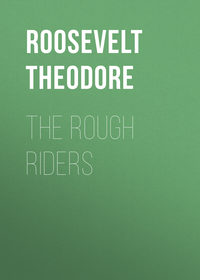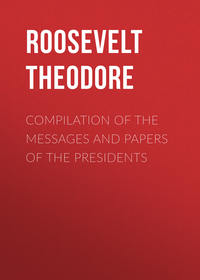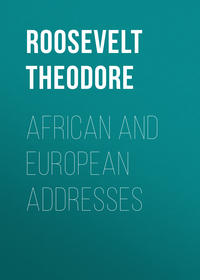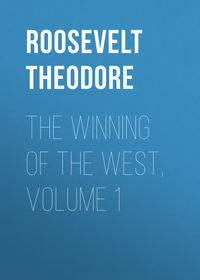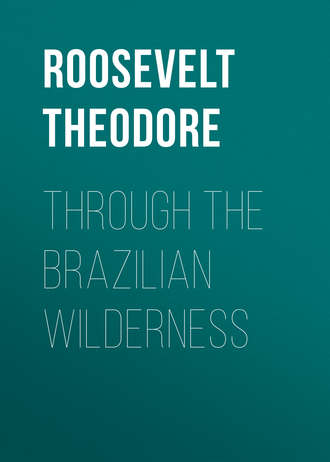 полная версия
полная версияThrough the Brazilian Wilderness
An immense amount of this true wilderness work, geographical and zoological, remains to be done in South America. It can be accomplished with reasonable thoroughness only by the efforts of very many different workers, each in his own special field. It is desirable that here and there a part of the work should be done in outline by such a geographic and zoological reconnaissance as ours; we would, for example, be very grateful for such work in portions of the interior of the Guianas, on the headwaters of the Xingu, and here and there along the eastern base of the Andes.
But as a rule the work must be specialized; and in its final shape it must be specialized everywhere. The first geographical explorers of the untrodden wilderness, the first wanderers who penetrate the wastes where they are confronted with starvation, disease, and danger and death in every from, cannot take with them the elaborate equipment necessary in order to do the thorough scientific work demanded by modern scientific requirements. This is true even of exploration done along the courses of unknown rivers; it is more true of the exploration, which must in South America become increasingly necessary, done across country, away from the rivers.
The scientific work proper of these early explorers must be of a somewhat preliminary nature; in other words the most difficult and therefore ordinarily the most important pieces of first-hand exploration are precisely those where the scientific work of the accompanying cartographer, geologist, botanist, and zoologist must be furthest removed from finality. The zoologist who works to most advantage in the wilderness must take his time, and therefore he must normally follow in the footsteps of, and not accompany, the first explorers. The man who wishes to do the best scientific work in the wilderness must not try to combine incompatible types of work nor to cover too much ground in too short a time.
There is no better example of the kind of zoologist who does first- class field-work in the wilderness than John D. Haseman, who spent from 1907 to 1910 in painstaking and thorough scientific investigation over a large extent of South American territory hitherto only partially known or quite unexplored. Haseman's primary object was to study the characteristics and distribution of South American fishes, but as a matter of fact he studied at first hand many other more or less kindred subjects, as may be seen in his remarks on the Indians and in his excellent pamphlet on "Some Factors of Geographical Distribution in South America."
Haseman made his long journey with a very slender equipment, his extraordinarily successful field-work being due to his bodily health and vigor and his resourcefulness, self-reliance, and resolution. His writings are rendered valuable by his accuracy and common sense. The need of the former of these two attributes will be appreciated by whoever has studied the really scandalous fictions which have been published as genuine by some modern "explorers" and adventurers in South America; and the need of the latter by whoever has studied some of the wild theories propounded in the name of science concerning the history of life on the South American continent. There is, however, one serious criticism to be made on Haseman: the extreme obscurity of his style—an obscurity mixed with occasional bits of scientific pedantry, which makes it difficult to tell whether or not on some points his thought is obscure also. Modern scientists, like modern historians and, above all, scientific and historical educators, should ever keep in mind that clearness of speech and writing is essential to clearness of thought and that a simple, clear, and, if possible, vivid style is vital to the production of the best work in either science or history. Darwin and Huxley are classics, and they would not have been if they had not written good English. The thought is essential, but ability to give it clear expression is only less essential. Ability to write well, if the writer has nothing to write about, entitles him to mere derision. But the greatest thought is robbed of an immense proportion of its value if expressed in a mean or obscure manner. Mr. Haseman has such excellent thought that it is a pity to make it a work of irritating labor to find out just what the thought is. Surely, if he will take as much pains with his writing as he has with the far more difficult business of exploring and collecting, he will become able to express his thought clearly and forcefully. At least he can, if he chooses, go over his sentences until he is reasonably sure that they can be parsed. He can take pains to see that his whole thought is expressed, instead of leaving vacancies which must be filled by the puzzled and groping reader. His own views and his quotations from the views of others about the static and dynamic theories of distribution are examples of an important principle so imperfectly expressed as to make us doubtful whether it is perfectly apprehended by the writer. He can avoid the use of those pedantic terms which are really nothing but offensive and, fortunately, ephemeral scientific slang. There has been, for instance, a recent vogue for the extensive misuse, usually tautological misuse, of the word "complexus"—an excellent word if used rarely and for definite purposes. Mr. Haseman drags it in continually when its use is either pointless and redundant or else serves purely to darken wisdom. He speaks of the "Antillean complex" when he means the Antilles, of the "organic complex" instead of the characteristic or bodily characteristics of an animal or species, and of the "environmental complex" when he means nothing whatever but the environment. In short, Mr. Haseman and those whose bad example he in this instance follows use "complexus" in much the same spirit as that displayed by the famous old lady who derived religious—instead of scientific— consolation from the use of "the blessed word Mesopotamia."
The reason that it is worth while to enter this protest against Mr. Haseman's style is because his work is of such real and marked value. The pamphlet on the distribution of South American species shows that to exceptional ability as a field worker he adds a rare power to draw, with both caution and originality, the necessary general conclusions from the results of his own observations and from the recorded studies of other men; and there is nothing more needed at the present moment among our scientific men than the development of a school of men who, while industrious and minute observers and collectors and cautious generalizers, yet do not permit the faculty of wise generalization to be atrophied by excessive devotion to labyrinthine detail.
Haseman upholds with strong reasoning the theory that since the appearance of all but the lowest forms of life on this globe there have always been three great continental masses, sometimes solid sometimes broken, extending southward from the northern hemisphere, and from time to time connected in the north, but not in the middle regions or the south since the carboniferous epoch. He holds that life has been intermittently distributed southward along these continental masses when there were no breaks in their southward connection, and intermittently exchanged between them when they were connected in the north; and he also upholds the view that from a common ancestral form the same species has been often developed in entirely disconnected localities when in these localities the conditions of environment were the same.
The opposite view is that there have been frequent connections between the great land masses, alike in the tropics, in the south temperate zone, and in the Antarctic region. The upholders of this theory base it almost exclusively on the distribution of living and fossil forms of life; that is, it is based almost exclusively on biological and not geological considerations. Unquestionably, the distribution of many forms of life, past and present, offers problems which with our present paleontological knowledge we are wholly unable to solve. If we consider only the biological facts concerning some one group of animals it is not only easy but inevitable to conclude that its distribution must be accounted for by the existence of some former direct land bridge extending, for instance, between Patagonia and Australia, or between Brazil and South Africa, or between the West Indies and the Mediterranean, or between a part of the Andean region and northeastern Asia. The trouble is that as more groups of animals are studied from the standpoint of this hypothesis the number of such land bridges demanded to account for the existing facts of animal distribution is constantly and indefinitely extended. A recent book by one of the most learned advocates of this hypothesis calls for at least ten such land bridges between South America and all the other continents, present and past, of the world since a period geologically not very remote. These land bridges, moreover, must, many of them, have been literally bridges; long, narrow tongues of land thrust in every direction across the broad oceans. According to this view the continental land masses have been in a fairly fluid condition of instability. By parity of reasoning, the land bridges could be made a hundred instead of merely ten in number. The facts of distribution are in many cases inexplicable with our present knowledge; yet if the existence of widely separated but closely allied forms is habitually to be explained in accordance with the views of the extremists of this school we could, from the exclusive study of certain groups of animals, conclude that at different periods the United States and almost every other portion of the earth were connected by land and severed from all other regions by water—and, from the study of certain other groups of animals, arrive at directly opposite and incompatible conclusions.
The most brilliant and unsafe exponent of this school was Ameghino, who possessed and abused two gifts, both essential to the highest type of scientist, and both mischievous unless this scientist possess a rare and accurate habit of thought joined to industry and mastery of detail:—namely, the gift of clear and interesting writing, and the gift of generalization. Ameghino rendered marked services to paleontology. But he generalized with complete recklessness from the slenderest data; and even these data he often completely misunderstood or misinterpreted. His favorite thesis included the origin of mammalian life and of man himself in southernmost South America, with, as incidents, the belief that the mammalian-bearing strata of South America were of much greater age than the strata with corresponding remains elsewhere; that in South America various species and genera of men existed in tertiary times, some of them at least as advanced as fairly well advanced modern savages; that there existed various land bridges between South America and other southern continents, including Africa; and that the ancestral types of modern mammals and of man himself wandered across one of these bridges to the old world, and that thence their remote descendants, after ages of time, returned to the new. In addition to valuable investigations of fossil-bearing beds in the Argentine, he made some excellent general suggestions, such as that the pithecoid apes, like the baboons, do not stand in the line of man's ancestral stem but represent a divergence from it away from humanity and toward a retrogressive bestialization. But of his main theses he proves none, and what evidence we have tells against them. At the Museum of La Plata I found that the authorities were practically a unit in regarding his remains of tertiary men and proto- men as being either the remains of tertiary American monkeys or of American Indians from strata that were long post-tertiary. The extraordinary discovery, due to that eminent scientist and public servant Doctor Moreno, of the remains of man associated with the remains of the great extinct South American fauna, of the mylodon, of a giant ungulate, of a huge cat like the lion, and of an extraordinary aberrant horse (of a wholly different genus from the modern horse) conclusively shows that in its later stages the South American fauna consisted largely of types that elsewhere had already disappeared and that these types persisted into what was geologically a very recent period only some tens of thousands of years ago, when savage man of practically a modern type had already appeared in South America. The evidence we have, so far as it goes, tends to show that the South American fauna always has been more archaic in type than the arctogeal fauna of the same chronological level.
To loose generalizations, and to elaborate misinterpretations of paleontological records, the kind of work done by Mr. Haseman furnishes an invaluable antiscorbutic. To my mind, he has established a stronger presumption in favor of the theory he champions than has been established in favor of the theories of any of the learned and able scientific men from whose conclusions he dissents. Further research, careful, accurate, and long extended, can alone enable us to decide definitely in the matter; and this research, to be effective, must be undertaken by many men, each of whom shall in large measure possess Mr. Haseman's exceptional power of laborious work both in the field and in the study, his insight and accuracy of observation, and his determination to follow truth with inflexible rectitude wherever it may lead—one of the greatest among the many great qualities which lifted Huxley and Darwin above their fellows.
APPENDIX B
The Outfit for Travelling in the South American WildernessSouth America includes so many different kinds of country that it is impossible to devise a scheme of equipment which shall suit all. A hunting-trip in the pantanals, in the swamp country of the upper Paraguay, offers a simple problem. An exploring trip through an unknown tropical forest region, even if the work is chiefly done by river, offers a very difficult problem. All that I can pretend to do is to give a few hints as the results of our own experience.
For bedding there should be a hammock, mosquito-net, and light blanket. These can be obtained in Brazil. For tent a light fly is ample; ours were brought with us from New York. In exploring only the open fly should be taken; but on trips where weight of luggage is no objection, there can be walls to the tent and even a canvas floor- cloth. Camp-chairs and a camp table should be brought—any good outfitter in the United States will supply them—and not thrown away until it becomes imperative to cut everything down. On a river trip, first-class pulleys and ropes—preferably steel, and at any rate very strong—should be taken. Unless the difficulties of transportation are insuperable, canvas-and-cement canoes, such as can be obtained from various firms in Canada and the United States, should by all means be taken. They are incomparably superior to the dugouts. But on different rivers wholly different canoes, of wholly different sizes, will be needed; on some steam or electric launches may be used; it is not possible to lay down a general rule.
As regards arms, a good plain 12-bore shotgun with a 30-30 rifle- barrel underneath the others is the best weapon to have constantly in one's hand in the South American forests, where big game is rare and yet may at any time come in one's path. When specially hunting the jaguar, marsh-deer, tapir, or big peccary, an ordinary light repeating rifle—the 30-30, 30-40, or 256—is preferable. No heavy rifle is necessary for South America. Tin boxes or trunks are the best in which to carry one's spare things. A good medicine-chest is indispensable. Nowadays doctors know so much of tropical diseases that there is no difficulty in fitting one out. It is better not to make the trip at all than to fail to take an ample supply of quinine pills. Cholera pills and cathartic pills come next in importance. In liquid shape there should be serum to inject for the stoppage of amoebic dysentery, and anti-snake-venom serum. Fly-dope should be taken in quantities.
For clothing Kermit and I used what was left over from our African trip. Sun helmets are best in the open; slouch-hats are infinitely preferable in the woods. There should be hobnailed shoes—the nails many and small, not few and large; and also moccasins or rubber-soled shoes; and light, flexible leggings. Tastes differ in socks; I like mine of thick wool. A khaki-colored shirt should be worn, or, as a better substitute, a khaki jacket with many pockets. Very light underclothes are good. If one's knees and legs are unfortunately tender, knickerbockers with long stockings and leggings should be worn; ordinary trousers tend to bind the knee. Better still, if one's legs will stand the exposure, are shorts, not coming down to the knee. A kilt would probably be best of all. Kermit wore shorts in the Brazilian forest, as he had already worn them in Africa, in Mexico, and in the New Brunswick woods. Some of the best modern hunters always wear shorts; as for example, that first-class sportsman the Duke of Alva.
Mr. Fiala, after the experience of his trip down the Papagaio, the Juruena, and the Tapajos, gives his judgment about equipment and provisions as follows:
The history of South American exploration has been full of the losses of canoes and cargoes and lives. The native canoe made from the single trunk of a forest giant is the craft that has been used. It is durable and if lost can be readily replaced from the forest by good men with axes and adzes. But, because of its great weight and low free-board, it is unsuitable as a freight carrier and by reason of the limitations of its construction is not of the correct form to successfully run the rapid and bad waters of many of the South American rivers. The North American Indian has undoubtedly developed a vastly superior craft in the birch-bark canoe and with it will run rapids that a South American Indian with his log canoe would not think of attempting, though, as a general thing, the South American Indian is a wonderful waterman, the equal and, in some ways, the superior of his northern contemporary. At the many carries or portages the light birch-bark canoe or its modern representative, the canvas-covered canoe, can be picked up bodily and carried by from two to four men for several miles, if necessary, while the log canoe has to be hauled by ropes and back-breaking labor over rollers that have first to be cut from trees in the forest, or at great risk led along the edge of the rapids with ropes and hooks and poles, the men often up to their shoulders in the rushing waters, guiding the craft to a place of safety.
The native canoe is so long and heavy that it is difficult to navigate without some bumps on the rocks. In fact, it is usually dragged over the rocks in the shallow water near shore in preference to taking the risk of a plunge through the rushing volume of deeper water, for reasons stated above. The North American canoe can be turned with greater facility in critical moments in bad water. Many a time I heard my steersman exclaim with delight as we took a difficult passage between two rocks with our loaded Canadian canoe. In making the same passage the dugout would go sideways toward the rapid until by a supreme effort her three powerful paddlers and steersman would right her just in time. The native canoe would ship great quantities of water in places the Canadian canoe came through without taking any water on board. We did bump a few rocks under water, but the canoe was so elastic that no damage was done.
Our nineteen-foot canvas-covered freight canoe, a type especially built for the purpose on deep, full lines with high free-board, weighed about one hundred and sixty pounds and would carry a ton of cargo with ease—and also take it safely where the same cargo distributed among two or three native thirty or thirty-five foot canoes would be lost. The native canoes weigh from about nine hundred to two thousand five hundred pounds and more.
In view of the above facts the explorer-traveller is advised to take with him the North American canoe if he intends serious work. Two canoes would be a good arrangement for from five to seven men, with at least one steersman and two paddlers to each canoe. The canoes can be purchased in two sizes and nested for transportation, an arrangement which would save considerable expense in freight bills. At least six paddles should be packed with each boat, in length four and one half, four and three fourths, and five feet. Other paddles from six and one half feet to eight and one half feet should be provided for steering oars. The native paddler, after he has used the light Canadian paddle, prefers it to the best native make. My own paddlers lost or broke all of their own paddles so as to get the North American ones, which they marked with their initials and used most carefully.
To each canoe it would be well to have two copper air tanks, one fore, one aft, a hand-hole in each with a water-tight screw cover on hatch. In these tanks could be kept a small supply of matches, the chronometer or watch which is used for position, and the scientific records and diary. Of course, the fact should be kept in mind that these are air tanks, not to be used so as to appreciably diminish their buoyancy. Each canoe should also carry a small repair kit attached to one of the thwarts, containing cement, a piece of canvas same as cover of canoe, copper tacks, rivets, and some galvanized nails; a good hatchet and a hammer; a small can of canoe paint, spar varnish, and copper paint for worn places would be a protection against termites and torrential downpours. In concluding the subject of canoes I can state that the traveller in South America will find no difficulty in disposing of his craft at the end of his trip.
MOTORS—We had with us a three and one half horse-power motor which could be attached to stern or gunwale of canoe or boat. It was made by the Evinrude Motor Company, who had a magneto placed in the flywheel of the engine so that we never had to resort to the battery to run the motor. Though the motor was left out in the rain and sun, often without a cover, by careless native help, it never failed us. We found it particularly valuable in going against the strong current of the Sepotuba River where several all-night trips were made up-stream, the motor attached to a heavy boat. For exploration up-stream it would be valuable, particularly as it is easily portable, weighing for the two horse-power motor fifty pounds, for three and one half horse-power one hundred pounds. If a carburetor could be attached so that kerosene could be used it would add to its value many times, for kerosene can be purchased almost anywhere in South America.
TENTS—There is nothing better for material than the light waterproof Sea Island cotton of American manufacture, made under the trade name of waterproof silk. It keeps out the heaviest rain and is very light. Canvas becomes water-soaked, and cravenetted material lets the water through. A waterproof canvas floor is a luxury, and, though it adds to the weight, it may with advantage be taken on ordinary trips. The tent should be eight by eight or eight by nine feet, large enough to swing a comfortable hammock. A waterproof canvas bag, a loose-fitting envelope for the tent should be provided. Native help is, as a rule, careless, and the bag would save wear and tear.
HAMMOCKS—The hammock is the South American bed, and the traveller will find it exceedingly comfortable. After leaving the larger cities and settlements a bed is a rare object. All the houses are provided with extra hammock hooks. The traveller will be entertained hospitably and after dinner will be given two hooks upon which to hang his hammock, for he will be expected to have his hammock and, in insect time, his net, if he has nothing else. As a rule, a native hammock and net can be procured in the field. But it is best to take a comfortable one along, arranged with a fine-meshed net.
In regard to the folding cot: It is heavy and its numerous legs form a sort of highway system over which all sorts of insects can crawl up to the sleeper. The ants are special pests and some of them can bite with the enthusiastic vigor of beasts many times their size. The canvas floor in a tent obviates to a degree the insect annoyance.
The headwaters of the rivers are usually reached by pack-trains of mules and oxen. The primitive ox-cart also comes in where the trail is not too bad. One hundred and sixty to one hundred and eighty pounds is a good load for the pack-animals, and none of the cases should weigh more than fifty or sixty pounds. Each case should be marked with its contents and gross and net weight in kilos.




